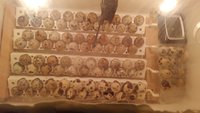pinoyathletics
Chirping
I'm considering doing a dry hatching Cortunix Quail this time.
I have this model of incubator
https://www.backyardchickens.com/threads/review-of-the-56-egg-no-brand-incubator.1139751/
Last time i hatched 23 of 39 using the factory settings 45-55 degree humidity then 60-70 at lock down sometime spiked upto 75-80 at times.
Im thinking of using the dry incubation of 15-30 and then 60-65 at lock down.
I have this model of incubator
https://www.backyardchickens.com/threads/review-of-the-56-egg-no-brand-incubator.1139751/
Last time i hatched 23 of 39 using the factory settings 45-55 degree humidity then 60-70 at lock down sometime spiked upto 75-80 at times.
Im thinking of using the dry incubation of 15-30 and then 60-65 at lock down.


